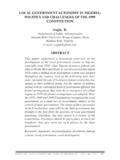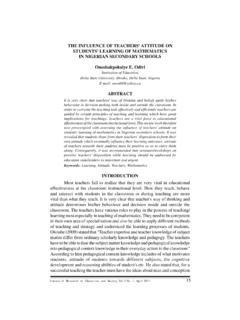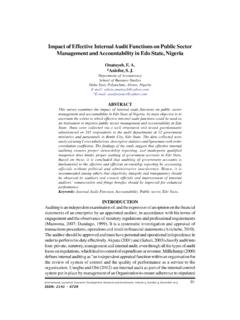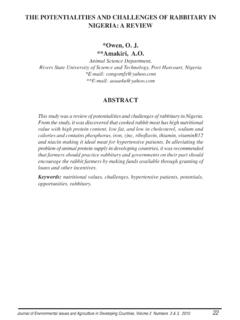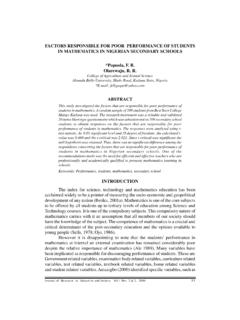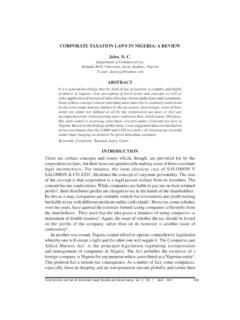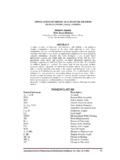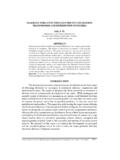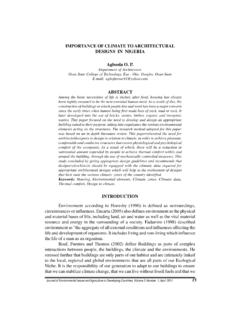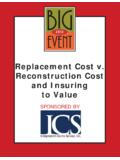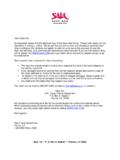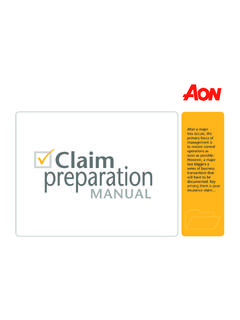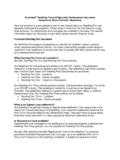Transcription of APPLICATION OF DEPRECIATION METHODS IN …
1 International Journal of Economic Development Research and Investment, Vol. 2 No. 1; April 2011 80 APPLICATION OF DEPRECIATION METHODS IN cost OFFIXED ASSETS IN SELECTED COMMERCIAL BANKSIN DAMATURU, YOBE STATE, NIGERIAA bdulmarooph Ola AdisaIkechi Eugene NkemDepartment of Accounting and FinanceMai Idris Alooma Polytechnic, Geidam, Yobe State, NigeriaABSTRACTThis study aims at analysing the various ways of charging DEPRECIATION , itsapplicability and its significance to some selected banks in Damaturu, YobeState capital. And at the same time, the effect of non-charging DEPRECIATION onbanks profitability and the effects of adhering traditionally to some particularmethods, the pros and cons of the METHODS in use.
2 Above all, the paper tends tostimulate the readers at a glance, the adopted suitable METHODS of depreciationfor the purpose of maintenance, renewal and replacement of fixed assets. Themethodology used in this research for the data collected is the survey method,where a stratified random sampling was applied on some staff of Bank PHB,UBA Group and Oceanic Bank International Plc as the recognition of the factthat the three has the common trait of dealing with the treatment of the fixedassets. The study revealed that companies would be declaring more profits ifsuitable METHODS of DEPRECIATION are properly applied.
3 Based on the findings ofthis study, it was recommended among others that companies should be objectivein their choice of the METHODS and rate of DEPRECIATION to be applied to avoidusing the wrong method or understating the rate as the case may : Depression, fixed assets, commercial banks, methodsINTRODUCTIOND epreciation is one of the important areas that need special attention inaccounting, because it affects the determination of the net profit of any is a measurement process, which is usually in monetary terms. Themeasurement process involves collecting, recording, presenting, analysing andinterpreting financial information for the users of financial statement.
4 Depreciationis the term used to describe the portion of cost of fixed assets which is deducted fromrevenue for the relative portion of assets services in the operation. It refers to theexpired (used up) cost of fixed assets. It has been observed that most Nigeriancompanies including banks do not care so much about the treatment of DEPRECIATION ,and if they do, they adhere mostly to the traditional METHODS of charging depreciationStraight or Fixed Instalment and Reducing or Diminishing Balance Method at theexpense of other METHODS irrespective of whether it is appropriate method or not.
5 Itis therefore high time that companies like banks recognised the significance of chargingdepreciation by endeavouring to use the appropriate METHODS that would give theactual usage of the Journal of Economic Development Research and Investment, Vol. 2 No. 1; April 201181 Generally, DEPRECIATION serves as an indicator of determination of assets dueto its engagement in the productive process. Therefore, DEPRECIATION would bedescribed accurately as that part of investment undertaken for replacement,maintenance and renewal purpose. The primary objective of providing for depreciationis not to measure the decline in value of the asset, rather to spread the cost of theasset over its useful life period.
6 In other words, the traditional objective of determiningdepreciation is not to measure the physical deterioration, or the fall in value of tangibleassets, but essentially to allocate the costs of the asset over its economic useful is therefore an expense and will need charging to Profit and Loss Accountbefore ascertaining net profit or loss. Provision for DEPRECIATION will therefore haveto be made in the books in order that the net profits may be profit remaining aftercharging DEPRECIATION during an accounting period. DEPRECIATION charges enable afirm to recognise the contribution of the various classes of fixed assets towards thegeneration of , despite the significance of DEPRECIATION of fixed asset to the firmprofitability ascertainment which facilitates growth and development, many firmsincluding banks often neglect its treatment in the relevant books of accounts.
7 In viewof that, there is need to study the various METHODS of charging DEPRECIATION and theimplications of using any particular method or the lack of APPLICATION of objective of this paper is to examine the various ways of chargingdepreciation, its applicability and its significance to some selected banks (specifically,Bank PHB, UBA Group, Oceanic Bank and Intercontinental Bank Plc.) in Damaturu,Yobe State capital. And at the same time, the paper tries to examine the effects of notcharging DEPRECIATION on banks profitability. Moreso, the paper seeks to investigatethe effects of adhering traditionally to a particular method of charging depreciationwould be Principles of Financial Statements and DepreciationThe financial statement of each organisation as demanded by the Companiesand Allied Matters Act (CAMA) 1990 should include the profit and loss account, thebalance sheet, the cash flow statement, the note to the account and some other relatedbooks.
8 Balance Sheet is the statement that shows the assets and liabilities of a firm ata particular period of time or statement that shows whether the business is insolventor solvent as the case may be. And the assets therefore categorised into tangible orintangible. Being tangible means those assets that can be vividly seen or touchedwhile intangible ones are those assets that cannot be seen or touched for example,goodwill, patent right trademarks etc. Tangible assets are further categorised intofixed assets and current assets. Fixed assets are those assets whose useful life exceedone year (that is to say, the assets that can last for a long period of time) these assetsare acquired using capital budgeting decision by the top level management of theorganisation, either at the beginning of the business or as the business , the assets of the business have to be adequately managed through properInternational Journal of Economic Development Research and Investment, Vol.
9 2 No. 1; April 2011 82planning of their acquisition, maintenance, replacement and renewal. The historicalcost convention of financial statements preparation requires that cost is the appropriatebasis for initial accounting recognition of all assets acquisition in the balance sheet soas not to over state their values. This therefore is in line with prudence assets are held by a business for a number of years for the purpose of effectiverunning of the business in line with this, the lost value of asset put to use for manyyears is what is seen as Wood (2002) defined DEPRECIATION as that part of original cost of fixedasset that is consumed during its period of use by the business.
10 DEPRECIATION can alsobe defined, in line with S. A. S. No. 9 as "the systematic and periodic allocation of thehistorical cost or revalued amount less estimated residual value of a depreciable assetover its estimated useful life. Dandago (1996) defines DEPRECIATION as the decreaseor reduction in the value of an asset (mostly fixed) as a result of wear and tear,passage of time or obsolescence. It can be viewed as the value diminishing due tonatural forces like rain, cold, sun etc. It is therefore, important to note that the lossin value of fixed assets is not attributed only to the constant usage of the asset butcould be as a result of passage of time or fashion.
